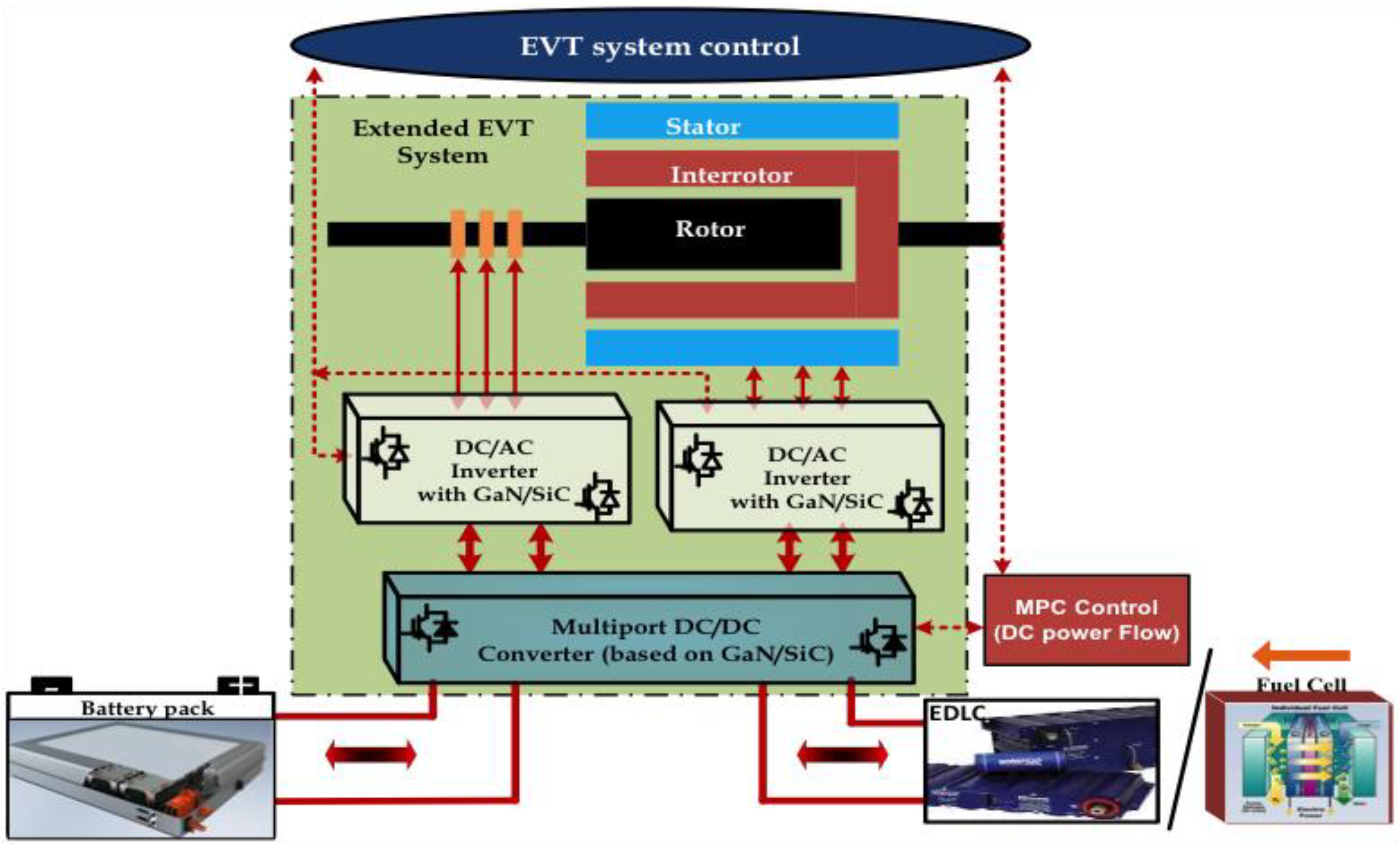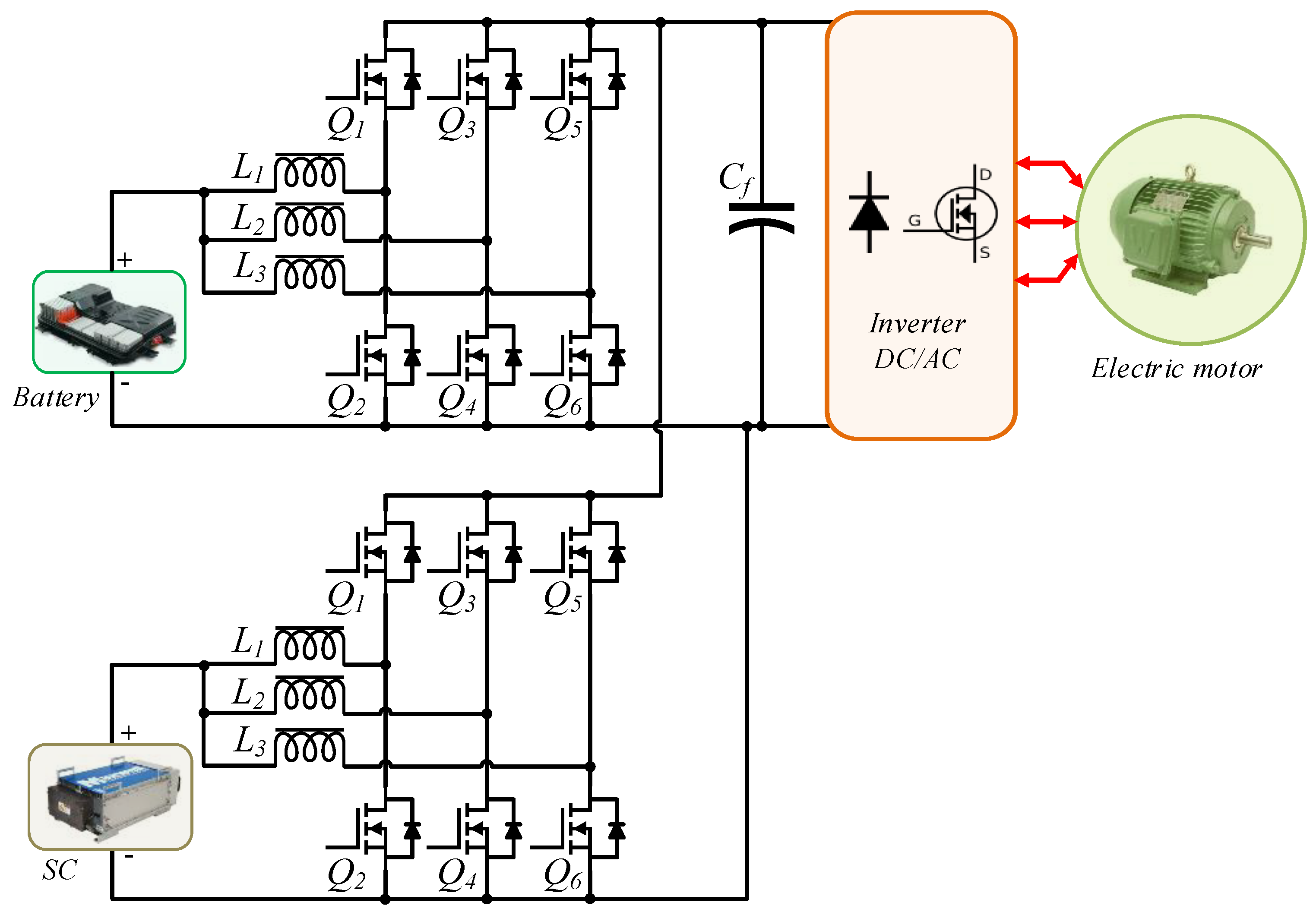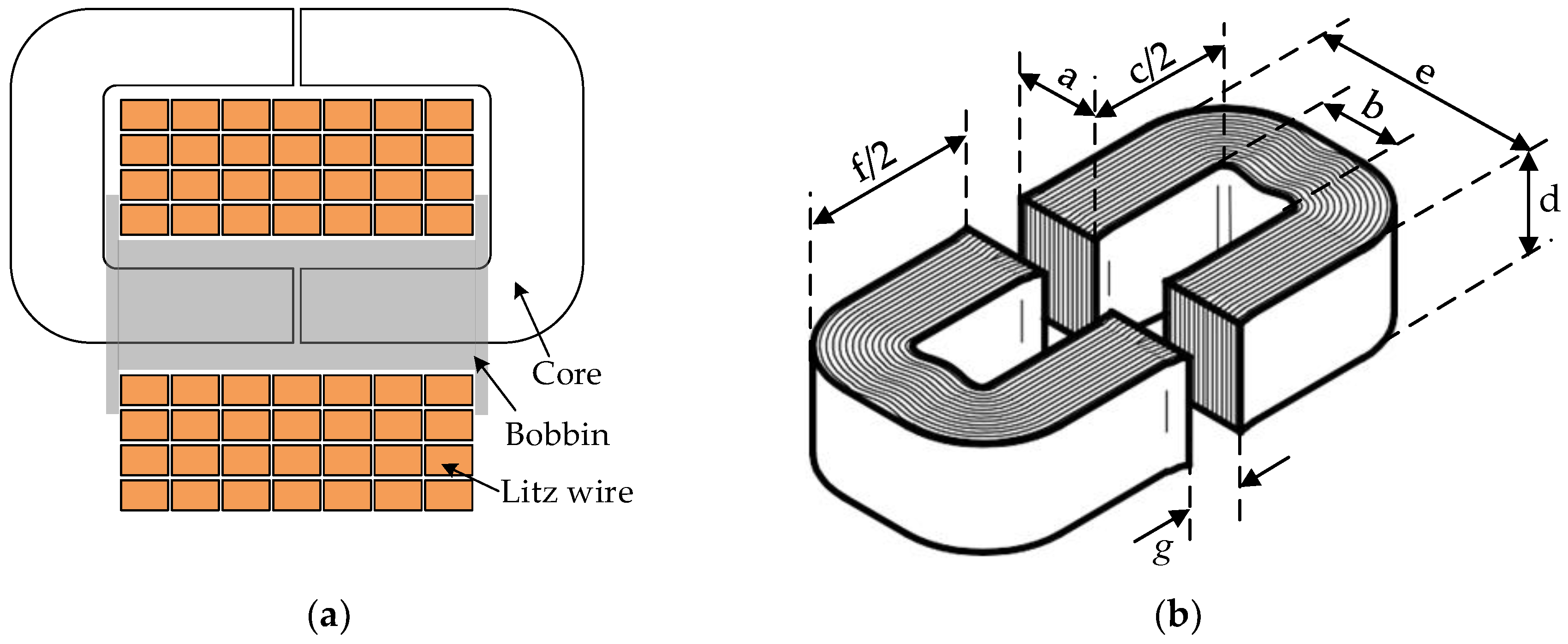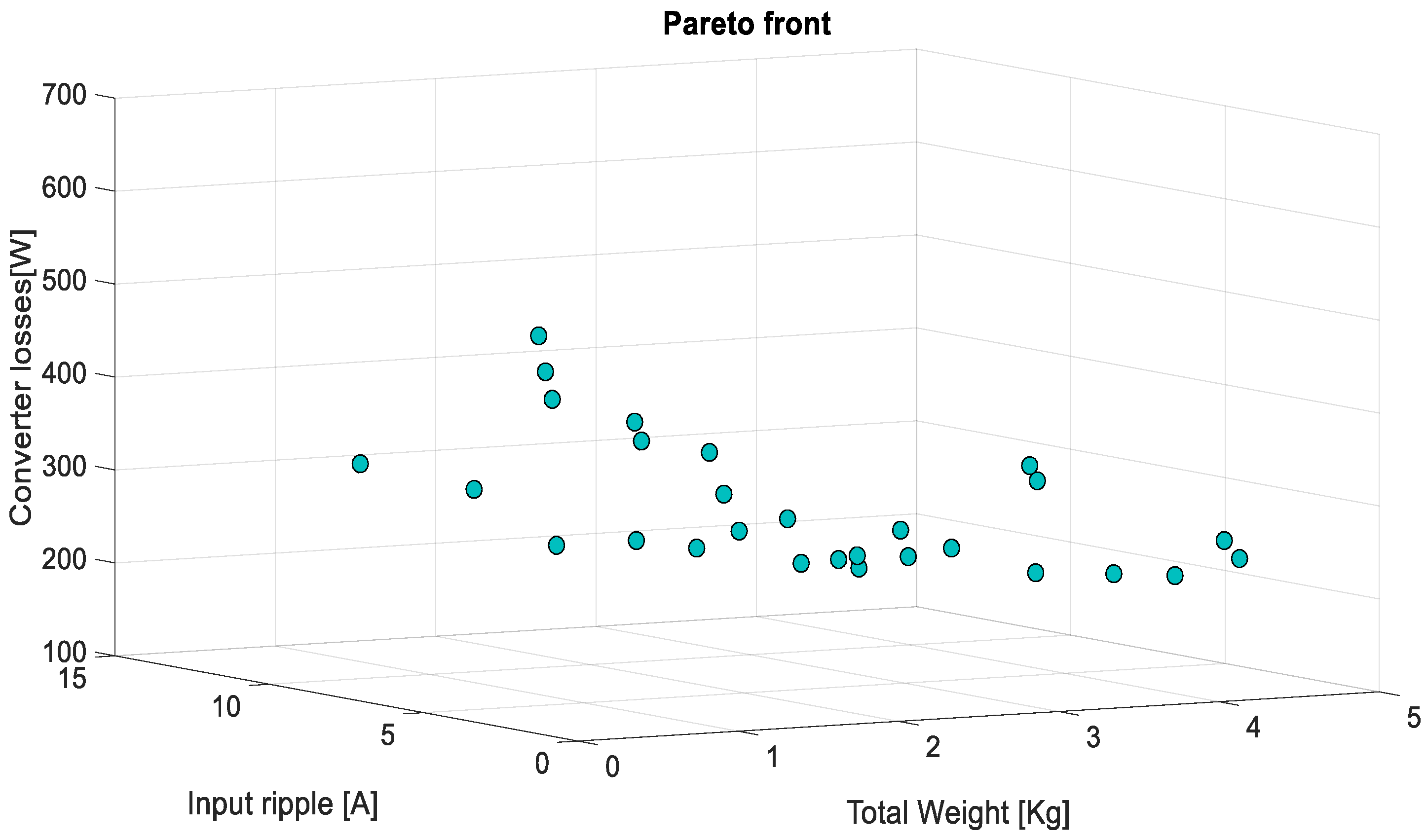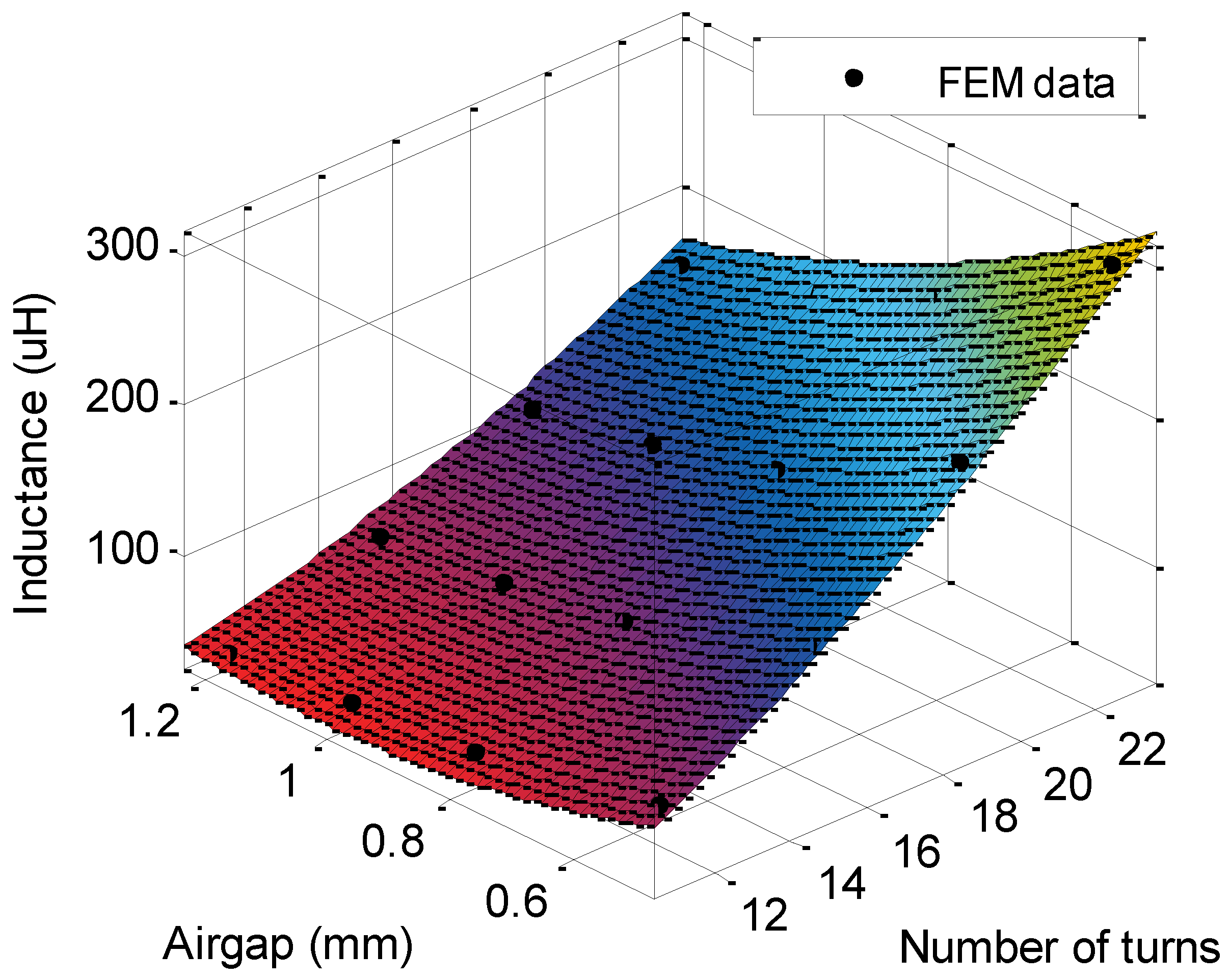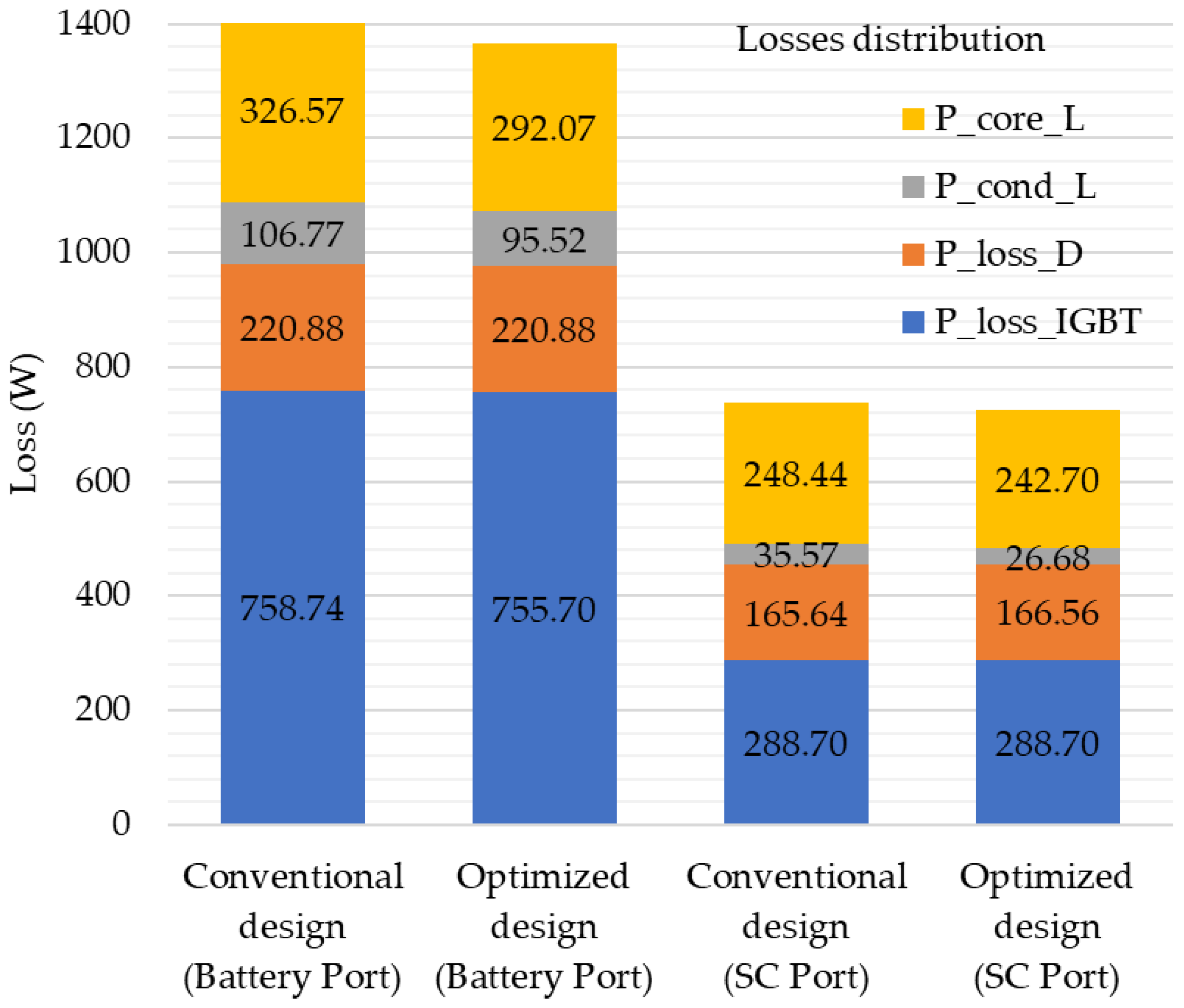1. Introduction
The recent technological developments in the fields of batteries, electric motors and power electronics interface (PEI) support electro-mobility transition. These advances introduce several possibilities, generating a broad variety of powertrain architectures as presented in [
1]. Multiport converters (MPCs) are increasingly attracting research interest. By employing MPC, it is possible to diversify the energy sources so that power system availability can be increased in hybrid electric powertrain systems. MPCs can provide a unique solution to combine multiple energy sources (i.e., battery, supercapacitor, fuel Cell), which have different voltage-current (V-I) characteristics and energy density versus power density performances.
Figure 1 illustrates the power distribution role of MPC in the Electric Variable Transmission (EVT)-based powertrain, which has been recognized as a promising and emerging technology for vehicles.
A family of MPCs is classified as non-isolated and isolated topology. In an isolated topology, the sources are usually connected to a half bridge converter to achieve DC-AC conversion, which allows the use of a high frequency transformer for high voltage ratios. In addition, the transformer enables the galvanic isolation between the inputs and outputs. Furthermore, with a transformer, it is easier to connect several outputs at different voltage level by properly selecting the number of turns of the secondary winding. However, for high power applications, the transformer is a bulky component. Thus, in vehicular applications, non-isolated topologies are preferred. Non-isolated MPC can be divided into parallel ports topologies and shared components topologies. The advantage of a shared component topology is that less switches are needed and thus the price is expected to be lower; however some topologies as presented in [
2] are unable to deliver energy simultaneously. Parallel ports instead inherently increase the system reliability as the ports can be driven either simultaneously or independently, relying on different active components [
3]. The advantage of paralleling the ports in a single converter is the gain in flexibility on the energy management techniques, compared to shared component. In fact, the ports can be controlled separately. In addition, better packaging and thermal management can be achieved compared to standard DC/DC converters. Despite being lighter compared to isolated converters, weight and cost is the main drawback in confront of shared components MPCs. Therefore, the interleaving technique can be applied to reduce the global converter weight and cost. Several MPCs have been developed based on [
3] as in [
4,
5], proving a high efficient and compact solution for vehicle applications with a centralized control.
Figure 2 shows a typical configuration of non-isolated bidirectional interleaved MPC in the vehicle powertrain.
The design of MPC power electronics system requires multidisciplinary knowledge and a large number of design variables in different engineering fields (electrical, magnetic, thermal, mechanical). The ability and expertise of the designer may end up with a good, but not optimal design. It may require more effort for further iterations through hardware prototype testing to obtain better performance in term of efficiency and weight. Therefore, mathematical optimization techniques and computer-aided software have been developed to tackle the design problem. In the literature, optimization for the power converter design can be classified into two main techniques: the gradient-based techniques using the derivative information and the metaheuristic-based techniques using the stochastic search. Several gradient-based methods have been employed for the optimization problem of power converter. Seeman et al. [
6] used the Nonlinear Programming (NP) based on Lagrangian functions to optimize a switched-capacitor converter. Wu et al. [
7] used the Augmented Lagrange Penalty Function (ALPF) technique to optimize a half-bridge dc-dc converter. Sergio et al. [
8] utilized the Sequential Quadratic Programming (SQP) for a boost power-factor-correction converter optimization. However, the main drawback of gradient-based algorithms is that if the design space contains several local minima, there is a possibility that a gradient-based optimizer may be trapped by a local minimum, and the result depends on the selection of the initial design point. So far in the literature, no existing gradient-based algorithms are able to find the global optimization solution [
9]. Furthermore, the gradient-based methods are mathematically guided algorithms, which require stringent mathematical formulations, causing a complexity of the system when variables increase. The metaheuristic-based optimization method was thus developed to solve the derivative-free and multi-objective problem with a large number of variables. Metaheuristic methods imitate the best features in nature, based on natural selection and social adaption. Among numerous metaheuristic methods, Genetic Algorithm (GA) [
10] and Particle Swarm Optimization (PSO) [
11] have been widely utilized to design the circuity of a power converter. The GA can be applied to optimize the medium-frequency transformer [
12] of isolated converter, heatsink and bus capacitor volumes [
13] of a three-phase inverter to archive minimum weight, losses and cost, with respect to constraints of design specification and physical limitation of components. The PSO, combined with Differential Evolution (DE), helps find an optimal transformer design for the Dual-Active-Bridge converter [
14], the resonant tank of isolate bidirectional series resonant converter [
15], and the inductor using EE core geometry [
16]. So far, almost all researches have formulated a single objective formulation (efficiency, or weight, or cost [
8]) or aggregated multiple conflicting objectives (weight, and loss, and cost) into one single objective. The multi-objective optimization of transformer design was solved by the Non-dominated Sorted Genetic Algorithm (NSGA-II) [
12]; however, the final design selected from Pareto-solutions was not explained clearly.
In this paper, a new optimization methodology as shown in
Figure 3 is proposed for the non-isolated interleaved MPC. The main characteristics of the interleaved converter are analyzed by predefined specifications such as maximum power
Pmax, input voltage
Vin, output voltage
Vout and required input current ripples
Iripple for battery and Supercapacitor (SC) ports, to derive objective functions that can be used for optimization problem formulation. A multi-objective genetic algorithm and Average Ranking technique are then employed to find three design variables (the number of phases
, switching frequency
, and core index representing geometry parameters of the core) to simultaneously minimize three trade-off objectives: weight of inductors, converter losses and input current ripples. To closely attain a practical design, a database was developed, which included commercial available inductor cores (23 cores) and Insulated Gate Bipolar Transistor (IGBT) modules (8 IGBT modules) for the optimization process. A hypothesis is that an optimal solution can be found in the database. The SOLIDWORKS software (Solidworks Premium 2018, Dassault Systèmes SolidWorks Corporation, Waltham, MA, USA, 2018) is then used to visualize the physical structure of optimal inductors that are imported into the COMSOL Multiphysics (Version 5.3a, COMSOL, Inc., Burlington, MA, USA, 2018), a Finite Element Method (FEM)-based software, to simulate the electromagnetic field of the designed inductor. The curve fitting Matlab function is also used to plot the inductance value in the function of air-gap and number of turns. The simulation results show reduction of weight in the optimized design compared to a conventional design.
The organization of this paper includes six sections.
Section 2 presents an analysis of input current ripple, weight of inductor, and converter losses.
Section 3 formulates the multiple objectives optimization problem.
Section 4 explains about the proposed design framework based on NSGA-II and Average Ranking method and
Section 5 discusses improvement in the optimized design compared to the conventional design. The conclusions are given in
Section 6.
2. Analysis of Non-Isolated Interleaved DC-DC Converter
As analyzed in the Introduction, isolated MPCs are usually used for low-power systems due to the limitation of magnetic designs for transformers. Non-isolated MPC topologies are more suitable for high-power powertrain system of vehicles. Thus, in this paper, the topology of MPC in
Figure 2 has been selected for optimization. The MPC consists of two Interleaved Bidirectional Converters (IBC) interfacing with a battery port and SC port, respectively. The objective of design optimization is to minimize input current ripple, converter losses, and inductor weight of IBC for each port. Some key parameters are foreseen intuitively to have an impact on optimization objectives. Firstly, if the switching frequency
increases, the size of the inductor core can be reduced; however, switching loss is increased. Secondly, the more number of phases added, the more current flowing in each phase can be reduced, leading to less semiconductor losses and reduction in inductor sizing. However, this adds more weight to the power electronics system. Finally, a bulky inductor can reduce the input current ripple that is important for battery lifespan; however, it introduces more weight and core losses. Therefore, the relationship of optimization objectives and design variables needs to be thoroughly analyzed.
2.1. Input Current Ripple
In the IBC, the phase interleaving technique enables one to decrease the input current ripple by shifting each interleaved phase by
such that the current is cancelled out, as shown in
Figure 4a. More phases are added in the interleaved converter; the
peak is further reduced for each additional phase added. However, even though the amplitude of the ripples is reduced, the frequency of the ripples increases with increase in the number of phases.
The input current ripple cancellation effect of an interleaved converter in the Continuous Conduction Mode (CCM) has been analyzed and quantified in [
17,
18,
19]. However, their derived equations are complicated to use in formulating the optimization problem. For the sake of convenience in the optimization process, we rewrite the function of input current ripple in terms of the duty ratio.
According to [
17,
18,
19], the function of input current ripple
with regard to the duty ratio
can be recognized as a parabolic equation,
, as shown in
Figure 4b. As can be seen, if the IBC has
phases, the peak of current ripple occurs separately in
regions of duty ratio. Each region is associated with an integer number
k ∈ [0,
−1].
The vertex of the parabola and the points where
is zero (dashed red circles in
Figure 4b) are considered to determine the coefficients a, b and c. It is noted that the peak of the inductor current ripple
in one single phase is calculated as Equation (1), therefore, the peak of the input current ripple
becomes Equation (2):
As a result, the input current ripple analytical equation can be derived by the following system in Equation (3):
By solving the system, the analytical expression of
is derived as Equations (4) and (5):
2.2. Weight of Inductors.
The weight of an inductor mainly consists of the weight of copper coil (or winding) and the weight of core. An inductor design is illustrated in
Figure 5. The weight of a coil
is dependent on the physical structure of winding (i.e., length, diameter, number of turns, and number of layers) while the weight of the core
is dependent on the type of core (i.e., material, shape). The air gap
is added to prevent saturation in the inductor.
To determine the weight of a coil
, it is first necessary to calculate the number of turns
as in Equation (6);
(−) is utilization factor,
is window area,
is cross section of the wire:
The diameter of the wire conductor
is calculated as Equation (7), where
is current density:
which gives the number of layers
as in Equation (8):
where the function
returns the nearest integer less than or equal to
X. And
is the height window of the core as shown in
Figure 5b.
The number of turns on each layer
is then calculated as Equation (9):
where the function
returns to the nearest integer with
X.
TThe length of the coil
as in Equation (10) is then based on the number of turns
, the number of layers
and the geometric parameters of the core (
and
in
Figure 5b).
The weight of the coil
is finally calculated as in Equation (11), where
is the mass density of copper:
For one port, the total weight of inductors
is based on the number of inductors according to the number of phases
, the weight of core
, the weight of coil
. (assumed that the weight of bobbin
is constant):
The inductor design is not straightforward. In practical design, the core is selected from available commercial products and the wire is decided by the amplitude of the inductor current. For the sake of optimization, it is necessary to derive the dependence of the inductance value on the design specifications (i.e., input current, switching frequency, output voltage). The main idea is that the designed inductor should guarantee the pre-defined current ripple which is also dependent on the duty cycle and the switching frequency
. In addition, the core of the inductor is not saturated. The inductance value
can be derived from a second-degree polynomial equation as Equation (13). The detailed derivation steps are explained in the
Appendix.
From Equation (13), it is possible to calculate the maximum inductance that can be achieved by a given core. It is obvious that out of the two roots of (13), only the real root has a physical meaning.
2.3. Losses of Converter
Losses of one phase consist of IGBT losses (conduction loss and switching loss), inductor losses (conduction loss and core loss) and air-gap loss. The loss caused by the skin effect can be neglected.
2.3.1. IGBT Losses and Diode Losses
The losses of IGBTs (
) and diodes (
) are due to the conduction losses and switching losses, which are evaluated based on [
20], but neglecting the effect of the temperature variation.
where the IGBT and diode characteristics (
,
,
,
,
,
,
,
, I
F and
) are given by the IGBT and diode datasheets; in addition, the effect of temperature variation is neglected.
,
,
and
are the switch and diode current.
2.3.2. Inductor Losses
The inductor losses consist of conduction loss
, core loss
, and air-gap loss
. As shown in Equation (17), the conduction loss
known as ohmic loss is dependent on the internal resistance of winding
. The core loss
as in Equation (18) are produced from the flux density ripple
, which is proportional to the inductor current ripple
. The core losses are estimated based on the charts given by the manufacturer (METGLAS, Inc., CC core) [
21]. In addition, high-frequency gap loss
in nanocrystalline cores [
22] can be computed as in Equation (19).
where
= 1.68 × 10
−3 a numerical constant, c (mm): the depth of the iron core.
The total losses of interleaved converter for one port is calculated in Equation (20).
4. NSGA-II Optimizer for the Proposed Optimization Design Framework
Figure 3 shows the flowchart of the proposed optimization framework based on Non-dominated Sorting Genetic Algorithm-II (NSGA-II) for the converter of individual ports in the MPC. The NSGA-II is the second version of the famous “Non-dominated Sorting Genetic Algorithm” based on the work of Prof. Kalyanmoy Deb et al., which solves non-convex and non-smooth single and multi-objective optimization problems. The detailed working principle of the NSGA-II can be found in [
23]. The NSGA-II can achieve good performance while solving a type of multidimensional problem defined in Equation (21) with discontinuous variable, providing highly accurate results with a reduced number of evaluations. The design methodology uses the large database of commercial standard core and IGBT modules to guarantee a hypothesis that the optimal core can be found in the database.
The main principle of the NSGA-II is that each design solution is represented by its chromosome made of the different genes, where the genes represent the integer associated with the design variable; the new design solutions are then produced by reproduction of the parents (design choices). The Blend Crossover (BLX) during the reproduction is based on the arithmetical average of each gene and a random variable α. In addition, polynomial mutation is also considered to introduce diversity in the design choices.
Based on the principle of NSGA-II [
23], in this research an existing Multi-Objective Genetic Algorithm (MOGA) has been modified. A built-in Matlab function called “gamultiobj” is used to create modified NSGA-II. In the Matlab setting “gaoptimset”, three primary functions are adapted: crossover operators (‘CrossoverFcn’), mutation operators (‘MutationFcn’) and the population selection of the next generation (‘CreationFcn’).
The presence of multiple objectives in a problem results in a set of Pareto-optimal solutions known as Pareto-front instead of a single optimal solution. A solution is called a Pareto-optimal solution if none of the objective functions can be improved in value without degrading some of the other objective values. Without any further information, one of these Pareto-optimal solutions cannot be said to be better than the other one, which demands a designer to find as many Pareto-optimal solutions as possible. Thus, the Average Ranking (AR) [
24] is employed to underpin the final solution from the Pareto-front. In the AR method, the tensor
is formulated as a three-dimensional matrix in Equation (23):
where
is the objective function and
is the design solution.
records −1, 0 or 1 depending on whether the choice
is better, equal to, or worse than
on objective
. The AR method calculates a score for each choice
by summing the ranks of
for each objective. For example, with 3 objectives, if
is 2nd best on two of those objectives and 5th best on the other, its AR score will be 2 + 2 + 5 = 9. Therefore, for
, where
is the Pareto set as Equation (24):
The inner sum calculates a score for for a given objective, and this will be 1 if is the best on that objective. Generally, z + 1 if z members of P are better at that objective.
5. Optimization Results Assessment
To validate the proposed optimization framework, the optimized design and a conventional design are needed to satisfy the same specification as summarized in
Table 1.
In the proposed optimization design, the upper bound and lower bound of design variables are defined in advance, as shown in
Table 2. To be more detailed, the setting of NSGA-II parameters is shown in
Table 3.
After executing the NSGA-II optimizer for the problem in Equation (21), the Pareto optimal solutions are sketched in
Figure 6. The final optimal solution found by AR method shows that the optimal number of phases is three and optimal switching frequency is 60 kHz. The optimal core is AMCC50 from Metglas® Inc, a subsidiary of Hitachi Metals America, Ltd, Conway, SC, USA.
For the sake of a fair comparison, the switching frequency and number of phases, both found from the proposed methodology, are kept unchanged to design inductors in the conventional design that are based on well-established equations of a boost converter.
The inductance value of conventional design, as shown in Equation (25), should be sufficient to ensure the predefined input current ripple under the worst case (minimum input voltage
).
The selected core is AMCC50 with cross-section area
, the maximum flux density
. Without air gap, number of turns in the conventional design can be calculated by Equation (26).
The conventional and optimal design of inductors for battery and SC port are shown in
Table 4. As can be seen, the inductance values increase from 166
(conventional design) to 177
(optimized design) for battery port, and from 148
(conventional design) to 150
(optimized design) for SC port even though the number of turns for both are reduced. The number of turns are reduced from 19 turns (conventional design) to 17 turns (optimized design) for the battery port, and from 18 turns (conventional design) to 15 turns (optimized design) for the SC port. It is understandable since the air-gaps 0.55 mm are added into the optimized inductor designs for two ports. As the results, the values of three objective functions are decreased considerably.
As shown before in Equation (12), the weight of the inductor consists of the weight of core, the weght of coil that is dependent on the length of wire, and the weight of the bobbin. The weight of AMCC50 core is 586 g and the weight of bobbin is 14 g. The Litz wire used for the wire of inductors is rectangular HF-LITZ WIRE covered with Polyester PET tape from Von Roll Isola France SA, Belfort, France, which has 0.2 kg/meter, 2600 strands, and the diameter of each strand is 0.1 mm. According to Equation (10), the length of wire for inductor coil can be calculated. Afterward, the weight of an inductor can be determined in a function of number of turns. For fast calculation, the relation between the weight of an inductor and the number of turns can be assumed as a 2nd-order polynomial curve that can be derived by using the fitting-curve function in Matlab as shown in Equation (27).
Figure 7 illustrates the relation described in Equation (27). As can see from
Table 4, the total weight of inductors is reduced by 20% and 17.6% for the battery port and the SC port, respectively.
Since the input current ripple and converter losses are highly dependent on the inductance value, it is important to ensure that the real inductor can obtain value as close as possible to that of theoretical inductance. To fulfill this purpose, the commercial COMSOL Multiphysics software is employed to compute the model of the inductor based on Finite Element Method.
Figure 8 illustrates the inductor design in SOLIDWORKS that is imported to the COMSOL software.
The material name of the core is METGLAS Alloy 2605SA1 that has high saturation flux density (1.56T) and a low loss resulting from micro-thin Metglas ribbon (25
). To ease the computation time, the fitting technique is also used to find the inductance value in a function of air-gaps and number of turns. To do so, 16 inductance values are generated from COMSOL Multiphysics with air-gap range from 0–1.2 mm and number of turns from 10–22 turns. Using Matlab fitting function, a 2nd-order polynomial surface can be found as Equation (28).
where
is inductance (µH);
is airgap (mm). The impact of air gap and number of turns is simulated by FEM. The result is fitted by 2-degree polynomial function, mentioned as above.
Figure 9 illustrates the impact of air-gap and the number of turns on the inductance value.
To calculate the reduction of losses, the SiC-based semiconductor switch (2MBI150U2A-060) is used and switching frequency is kept as 60 kHz. The power losses of converters at full load 30 kW are reduced by 3.5% and 2.02% for battery port and SC port, respectively. More reduction of total loss, 7.2% and 2.56% for battery and SC port respectively, can be seen at low load 5 kW. The losses distribution at full load is shown in detail in
Figure 10.
The maximum input current ripple current, which is considered as a third objective function is also reduced by 38% and 34% for battery and SC converter ports, respectively. All diminution values that are shown in
Table 4 validate the optimization methodology based on a multi-objective genetic algorithm and Average Ranking technique.
6. Conclusions
Several MPC topologies have been proposed in recent years with the aim to decrease the weight and component counts of DC/DC converters applied in hybrid drivetrain systems. Thus, the complex multidisciplinary design of these converters is a key challenge in the development phase of vehicle or machine drivetrains.
In this paper, a new optimization methodology based on Nondominated Sorting Genetic-Algorithm-II has been developed for MPC design to find optimization variables: a number of phases, inductor design, and switching frequency. The Average Ranking method is proposed to finalize the optimal solution among several Pareto-front solutions. Theoretically, the optimized design can archive better performance than the conventional design in terms of weight of inductors, input current ripple, and converter losses. The Finite Element Method such as COMSOL software is used to validate inductor designs, which is a crucial step for the future work. The proposed optimization process opens up new possible configurations in the optimization of MPC. Future research will involve the development of high-fidelity models of inductor design considering fringing effects, and fabrication of the prototype of MPC to validate design methodology compared to conventional design.
